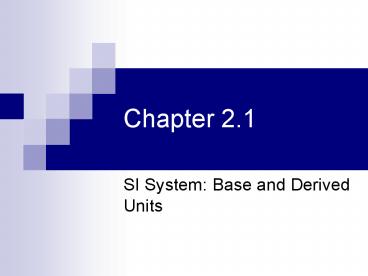SI System: Base and Derived Units PowerPoint PPT Presentation
1 / 16
Title: SI System: Base and Derived Units
1
Chapter 2.1
- SI System Base and Derived Units
2
SI System
- Le Systeme International dUnites
- International System of Units
- Often called the metric system
3
Why do we need this?
- When no one left their own community, it didnt
really matter. - 1.5 killmers of cookies would be a perfectly
acceptable unit of measure, if everyone had a
killmer to refer to. - As we become more global, common means of sharing
ideas becomes more significant.
4
The SI System Base Units
5
Sometimes the units dont match the size we need
- It doesnt make sense to measure the thickness of
a piece of paper with a meter-stick - So we subdivide the units, rather than make up
new ones
6
Some common prefixes
7
Lets try some
- How many grams in a kilogram?
- How many centimeters in a meter?
- How many deciliters in a liter?
- How many killmers in a hectokillmer?
- 1000
- 100
- 10
- 100
8
We find these all over
- What does the k in Y2k mean?
- How many years in a century?
- How many years in a millenium?
- How many tons in a 10 megaton bomb?
9
Approximating
- 1 meter is about the height of a doorknob.
- 1 cm is about the width of a button.
- 1 mm is about the thickness of a dime.
- 1 kg is about the mass of a small text book.
- 1 g is about the mass of a dollar bill.
- 1 mg is about the mass of 10 grains of salt.
10
Base Units vs. Derived Units
- Base units are the simplest units.
- We can combine base units to make derived units.
- A derived unit is used to measure those things
that are not part of the base options
11
Derived Unit
- If I want to measure the volume for a cube, I
need to use a derived unit. - V length x length x length
- V m x m x m
- V m3
- A cubic meter is a derived unit built from base
units.
12
Density
- One of the first needs we will have for derived
units involves density. - Density is the amount of mass in a given volume.
- D mass / volume
13
Unit for density
- Since density doesnt have a base unit, we have
to build one. - D mass / volume
- D kg / m3
- The nice part is, we can use any mass or volume
units to do this
14
Density Sample
- What is the density of a block of metal that has
a mass of 2.50 grams and occupies a volume of .20
ml? - D mass/volume
- D (2.50 g)/(.20 ml)
- D 12.50 g/ml
15
Rearranging the formula
- We can use algebra tricks to rearrange our
density formula if we need to - D mass/volume
- VolumeD mass
- Volume mass/D
16
Assignment
- Read Lab 2 for next time

